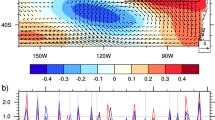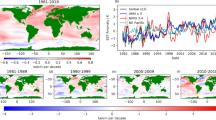Abstract
Longitude-time evolution of sea surface temperature anomalies (SSTA) reveals a slow southeastward propagation from the western North Pacific (WNP) around 20°N to the Niño-3.4 region in the equatorial Central Pacific. The propagation is manifested as a narrow, southwest-northeast oriented SSTA band across the subtropical North Pacific, and its journey takes about 2–3 years. The propagating SSTA appears to engage the initiation of the El Niño–Southern Oscillation (ENSO). The anomalies of surface winds, sea level pressure, outgoing longwave radiation, and velocity potential all exhibit a concurrent and distinct eastward propagation, one that appears to be circumglobal and is coupled with the predominant 4–5 year frequency of the ENSO cycle. It is suggested that the previously found warming/cooling in the Indian Ocean induced by El Niño/La Niña, the progressive SSTA and wind anomalies across the Indian Ocean towards the WNP, and the predominant 4–5-year frequency of the North Pacific Oscillation collectively contribute to the reported SSTA propagation . The findings implicate that monitoring the SSTA propagation from the WNP towards the tropical central Pacific could be useful in tracking the ENSO development.









Similar content being viewed by others
References
Alexander MA, Vimont DJ, Chang P, Scott JD (2010) The impact of extratropical atmospheric variability on ENSO: testing the seasonal footprinting mechanism using coupled model experiments. J Clim 23(11):2885–2901
Anderson BT (2003) Tropical Pacific sea surface temperatures and preceding sea level pressure anomalies in the subtropical North Pacific. J Geophys Res 108(D23). doi:10.1029/2003JD003805
Barnett T (1983) Interaction of the monsoon and Pacific trade wind system at interannual time scales part I: the equatorial zone. Mon Wea Rev 111(4):756–773
Behringer DW, Ji M, Leetmaa A (1998) An improved coupled model for ENSO prediction and implications for ocean initialization part I: the ocean data assimilation system. Mon Wea Rev 126(4):1013–1021
Bejarano L, Jin F-F (2008) Coexistence of equatorial coupled modes of ENSO*. J Clim 21(12):3051–3067
Cayan DR (1992) Latent and sensible heat flux anomalies over the Northern Oceans: the connection to monthly atmospheric circulation. J Clim 5(4):354–369
Chang P, Zhang L, Saravanan R, Vimont DJ, Chiang JC, Ji L, Seidel H, Tippett MK (2007) Pacific meridional mode and El Nino-Southern oscillation. Geophys Res Lett 34(16):L16608
Chiang JCH, Vimont DJ (2004) Analogous Pacific and Atlantic Meridional modes of tropical atmosphere–ocean variability. J Clim 17(21):4143–4158
Chowdary JS, Xie S-P, Luo J-J, Hafner J, Behera S, Masumoto Y, Yamagata T (2011) Predictability of Northwest Pacific climate during summer and the role of the tropical Indian Ocean. Clim Dyn 36(3–4):607–621
Chowdary JS, Xie S-P, Tokinaga H, Okumura YM, Kubota H, Johnson N, Zheng X-T (2012) Interdecadal variations in ENSO teleconnection to the Indo-Western Pacific for 1870–2007*. J Clim 25(5):1722–1744
Clarke AJ (2008) An introduction to the dynamics of El Nino and the Southern oscillation. Academic Press, London, p 308
Clarke AJ, Van Gorder S (2003) Improving El Niño prediction using a space-time integration of Indo-Pacific winds and equatorial Pacific upper ocean heat content. Geophys Res Lett 30(7):1399
Clarke AJ, Liu X, Van Gorder S (1998) Dynamics of the biennial oscillation in the equatorial Indian and far western Pacific Oceans. J Clim 11(5):987–1001
Dickey JO, Marcus SL, de Viron O (2003) Coherent interannual and decadal variations in the atmosphere–ocean system. Geophys Res Lett 30(11):1573
Du Y, Yang L, Xie S-P (2011) Tropical Indian Ocean influence on Northwest Pacific tropical cyclones in summer following strong El Niño*. J Clim 24(1):315–322
Enfield DB, Mayer DA (1997) Tropical Atlantic sea surface temperature variability and its relation to El Niño-Southern oscillation. J Geophys Res Ocean (1978–2012) 102(C1):929–945
Gutzler DS, Harrison D (1987) The structure and evolution of seasonal wind anomalies over the near-equatorial eastern Indian and western Pacific Oceans. Mon Wea Rev 115(1):169–192
Hendon HH (2003) Indonesian rainfall variability: impacts of ENSO and local air–sea interaction. J Clim 16(11):1775–1790
Huang G, Hu K, Xie S-P (2010) Strengthening of tropical Indian Ocean teleconnection to the Northwest Pacific since the mid-1970s: an atmospheric GCM study*. J Clim 23(19):5294–5304
Huang W-R, Chen T-C, Wang S-Y (2012) Co-variability of poleward propagating atmospheric energy with tropical and higher-latitude climate oscillations. Clim Dyn 39(7–8):1905–1912
Iacobucci A, Noullez A (2005) A frequency selective filter for short-length time series. Comput Econ 25:75–102
Izumo T, Vialard J, Lengaigne M, de Boyer Montegut C, Behera SK, Luo J-J, Cravatte S, Masson S, Yamagata T (2010) Influence of the state of the Indian Ocean dipole on the following year’s El Nino. Nat Geosci 3(3):168–172
Jin FF, An SI (1999) Thermocline and zonal advective feedbacks within the equatorial ocean recharge oscillator model for ENSO. Geophys Res Lett 26(19):2989–2992
Kalnay E et al (1996) The NCEP/NCAR 40-year reanalysis project. Bull Am Meteor Soc 77(3):437–471
Klein SA, Soden BJ, Lau N-C (1999) Remote sea surface temperature variations during ENSO: evidence for a tropical atmospheric bridge. J Clim 12(4):917–932
Lin H, Derome J, Greatbatch RJ, Andrew Peterson K, Lu J (2002) Tropical links of the Arctic oscillation. Geophys Res Lett 29(20):1943
Linkin ME, Nigam S (2008) The north pacific oscillation-west Pacific teleconnection pattern: mature-phase structure and winter impacts. J Clim 21(9):1979–1997
Mann M, Park J (1996) Greenhouse warming and changes in the seasonal cycle of temperature: model versus observations. Geophys Res Lett 23(10):1111–1114
McPhaden MJ (1999a) El Nino: the child prodigy of 1997–98. Nature 398(6728):559–562
McPhaden MJ (1999b) Genesis and evolution of the 1997–98 El Niño. Science 283(5404):950–954
Meehl GA (1987) The annual cycle and interannual variability in the tropical Pacific and Indian Ocean regions. Mon Wea Rev 115(1):27–50
Meyers G, McIntosh P, Pigot L, Pook M (2007) The years of El Niño, La Niña, and interactions with the tropical Indian Ocean. J Clim 20(13):2872–2880
Neelin JD, Battisti DS, Hirst AC, Jin FF, Wakata Y, Yamagata T, Zebiak SE (1998) ENSO theory. J Geophys Res Ocean (1978–2012) 103(C7):14261–14290
Penland C, Sardeshmukh PD (1995) The optimal growth of tropical sea surface temperature anomalies. J Clim 8(8):1999–2024
Rodríguez-Fonseca B, Polo I, García-Serrano J, Losada T, Mohino E, Mechoso CR, Kucharski F (2009) Are Atlantic Niños enhancing Pacific ENSO events in recent decades? Geophys Res Lett 36(20):L20705
Rogers JC (1981) The North Pacific oscillation. J Climatol 1(1):39–57
Smith TM, Reynolds RW, Peterson TC, Lawrimore J (2008) Improvements to NOAA’s historical merged land–ocean surface temperature analysis (1880–2006). J Clim 21(10):2283–2296
Takayabu YN, Iguchi T, Kachi M, Shibata A, Kanzawa H (1999) Abrupt termination of the 1997–98 El Nino in response to a Madden–Julian oscillation. Nature 402(6759):279–282
Taylor KE, Stouffer RJ, Meehl GA (2011) An overview of CMIP5 and the experiment design. Bull Am Meteor Soc 93(4):485–498
Tourre YM, White WB (1997) Evolution of the ENSO signal over the Indo-Pacific domain*. J Phys Oceanogr 27(5):683–696
Vialard J, Menkes C, Boulanger J-P, Delecluse P, Guilyardi E, McPhaden MJ, Madec G (2001) A model study of oceanic mechanisms affecting equatorial Pacific sea surface temperature during the 1997–98 El Niño. J Phys Oceanogr 31(7):1649–1675
Vimont DJ, Battisti DS, Hirst AC (2001) Footprinting: a seasonal connection between the tropics and mid-latitudes. Geophys Res Lett 28(20):3923–3926
Vimont DJ, Wallace JM, Battisti DS (2003) The seasonal footprinting mechanism in the Pacific: implications for ENSO. J Clim 16(16):2668–2675
Walker GT, Bliss EW (1932) World weather V. Mem Roy Meteor Soc 4:53–84
Wallace JM, Gutzler DS (1981) Teleconnections in the geopotential height field during the Northern Hemisphere winter. Mon Wea Rev 109(4):784–812
Wang B, Wu R, Fu X (2000) Pacific-East Asian teleconnection: how does ENSO affect East Asian climate? J Clim 13(9):1517–1536
Wang L, Chen W, Huang R (2007) Changes in the variability of North Pacific oscillation around 1975/1976 and its relationship with East Asian winter climate. J Geophys Res Atmos 112(D11):D11110
Wang S-Y, L’Heureux M, Chia H-H (2012) ENSO prediction one year in advance using western North Pacific sea surface temperatures. Geophys Res Lett 39(5):L05702
Wang S-Y, L’Heureux M, Yoon J-H (2013) Are greenhouse gases changing ENSO precursors in the Western North Pacific? J Clim 26:6309–6322
White WB, Tourre YM, Barlow M, Dettinger M (2003) A delayed action oscillator shared by biennial, interannual, and decadal signals in the Pacific Basin. J Geophys Res 108(C3):1511–1518
Xie S-P, Annamalai H, Schott FA, McCreary JP Jr (2002) Structure and mechanisms of south Indian Ocean climate variability*. J Clim 15(8):864–878
Xie S-P, Hu K, Hafner J, Tokinaga H, Du Y, Huang G, Sampe T (2009) Indian Ocean capacitor effect on Indo-Western Pacific climate during the summer following El Niño. J Clim 22(3):730–747
Xie S-P, Du Y, Huang G, Zheng X-T, Tokinaga H, Hu K, Liu Q (2010) Decadal shift in El Niño influences on Indo-Western Pacific and East Asian climate in the 1970s*. J Clim 23(12):3352–3368
Yang J, Liu Q, Xie S-P, Liu Z, Wu L (2007) Impact of the Indian Ocean SST basin mode on the Asian summer monsoon. Geophys Res Lett 34(2):L02708
Yu J-Y, Mechoso CR, McWilliams JC, Arakawa A (2002) Impacts of the Indian Ocean on the ENSO cycle. Geophys Res Lett 29(8):4641–4644
Acknowledgments
Useful discussions with Michelle L'Heureux and TC Chen are highly appreciated. This study was supported by the NASA Grant NNX13AC37G and by the United States Agency for International Development Grant EEM-A-00-38310-00001.
Author information
Authors and Affiliations
Corresponding author
Electronic supplementary material
Below is the link to the electronic supplementary material.
Rights and permissions
About this article
Cite this article
Simon Wang, SY., Jiang, X. & Fosu, B. Global eastward propagation signals associated with the 4–5-year ENSO cycle. Clim Dyn 44, 2825–2837 (2015). https://doi.org/10.1007/s00382-014-2422-z
Received:
Accepted:
Published:
Issue Date:
DOI: https://doi.org/10.1007/s00382-014-2422-z




